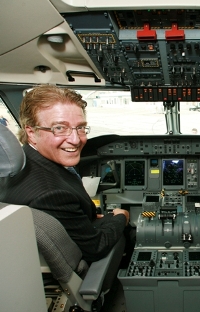This airline may have a raccoon for its mascot, but Porter Airlines is very much a different animal among start-ups, flying only turboprops on point-to-point routes and using a small airport that is close-in to the city centre. It is growing dramatically, and internationally as well as domestically, making Porter a rarity among airline start-ups.
Porter uses Toronto's City Centre airport, which is so close to the downtown of Canada's largest city and major business hub that a traveller can (theoretically, at least) leave an office in the financial district, go to the airport by ferry and be airborne in about the same time it takes a passenger to get to Toronto's mammoth Pearson International and get through the lines to a flight. A flight from the little airport on an island can cut about two hours off the total travel time from Pearson, claims Porter's founder, chief executive and president, Robert Deluce.
Getting started at the City Centre airport was a major struggle, Deluce recalls, noting that "we have been in court 12 or more times over using the airport and expanding here" despite the objections of Air Canada's Jazz regional affiliate and opposition from anti-growth neighbours.
 |
|---|
Deluce notes that Porter tried to meet neighbours' concerns about noise and emissions by choosing Bombardier's DeHavilland Q400, a 70-seater that in addition to running quietly and cleanly has the advantage of being manufactured in a nearby part of Toronto. From the first flight in October 2006, a flight met by picketers and protesters but filled with paying passengers, the aircraft has done well. The airline should have 18 of the type by year-end, up from eight now.
Because Porter is private, funded by venture capital, Deluce will not give out fiscal or operational results, but he notes the carrier just paid out profit-sharing to its employees for its fiscal first quarter. He says that some of the routes Porter flies will need more capacity soon because of growing demand. Some flights enjoy an 80% load factor, Porter says.
Porter began with flights linking Toronto with the nation's capital, Ottawa, and has added Montréal, completing the triangle of major Canadian cities that are also competitive with high-speed rail as well as air. The airline also serves Quebec City and Mt. Tremblant, a Quebec ski resort, with weekend service.
Porter began its US transborder expansion with service to New York City via Newark Liberty Airport that route now has seven daily weekday frequencies. Newark began in June of 2008. In late November of last year, Porter began service to Chicago's Midway Airport and increased it to six daily returns or roundtrips on weekdays in early January. Deluce raves about this route because "Midway was just ideal, being as close-in as it is."
Adding US cities is major goal for Deluce this year. It has three US cities on its list at least one of them will begin in the spring and another should be added for the fall or autumn schedule. The cities are Boston, Philadelphia, and Washington. Boston is likely to be the first new US city. "We're looking at all three Washington-area airports and we're going to have to select very carefully," he says of the choice among Reagan Washington National, a close-in airport, Washington Dulles, which is farther out but has more international flights, or Baltimore/Washington International (BWI). "If we are not certain which Washington airport we'll choose or can't get the one we want, then maybe Philadelphia would move up the list," he says, hinting at National by adding, "Ideally, we would want to go from a downtown airport to downtown airport."
"With added lift, we'll also increase our frequencies on some of the Canadian routes we're seeing lot of demand on Montréal and Ottawa, and we'll probably make Halifax (in Nova Scotia, in the eastern Maritimes) a year-round destination instead of a seasonal one," he says. The Halifax flights, which are weekends-only, stop in Ottawa. New Canadian cities will be chosen from a list of cities such as Thunder Bay, or Sault Ste. Marie, possibly Windsor, all within Ontario's provincial borders.
Toronto's City Centre Airport, built on 200 acres in Lake Ontario, has a place in Deluce's heart: "I took my first official scheduled flying lessons here, when it was called Island Airport back in the 1960s," he says. Asked what he means by 'official,' Deluce laughs and says, "The family was an aviation family. My father had an aviation enterprise and I guess you could say I was always part of the family business."
Porter to order more Q400s? Click here to read Left Field's blog to find out more
Source: Airline Business



















